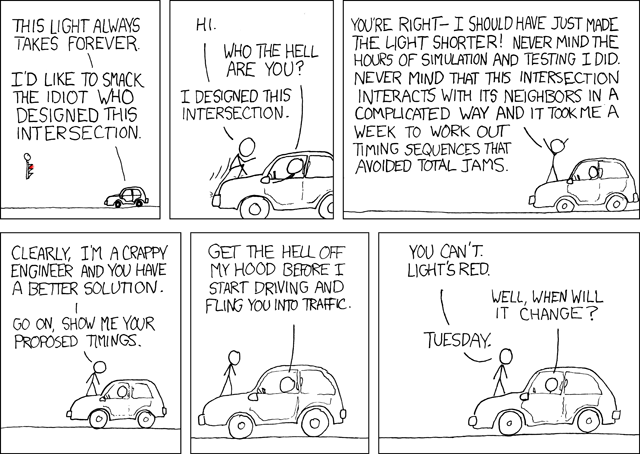Went to an aldermen committee meeting and a thoughtful discussion about mixed-use zoning broke out.
I kid.
But in all seriousness, last night's consideration of the proposed Planned Business District was particularly thoughtful, with a bunch of important points raised and considered. I'll post about some of them over the next few days (here and on the Garden City blog).
Let me start with maximums on trip generation, presented last night as post-construction traffic study.
Under a trip-generation maximum scheme, before construction the city and developer would agree on reasonable trip generation for the project, based on projections. Some time after construction and occupancy, the city and developer will measure actual trip generation. If the actuals are too much higher (say 10%) than the estimates, the developer will take measures to reduce trip generation.
As Phil Herr pointed out quite eloquently at the second public hearing on New England Development's PBD proposal, when a developer offers pre-construction trip projections, he implicitly acknowledges that the development can be profitable with those number of trips. Enforceable maximums take the implicit and turn it into a commitment. The city will permit a sufficient number of trips to allow the developer to succeed. The developer promises to limit development to those number of trips.
The key insight is that trip generation can be managed. There are all sorts of mechanisms, primarily on-site, that can discourage visitors: higher parking fees, reduced parking, programs to encourage alternative transportation, &c. And, there's always the nuclear bomb: forced vacancy.
A good point of reference is New England Development's attorney John Twohig question last night: If one of the tenants is particularly successful, am I supposed to tell him, sorry, you're too successful, gotta shut you down? (I'm paraphrasing.)
Attorney Twohig overloads the question with assumptions, so let's break it down.
If a tenant is so unexpectedly successful that trip generation goes over the developer's commitments, is the developer going to have to do something?
Yes. The trip-generation limit represents a bargain between the community and the developer. A developer can create enough traffic to make a project successful, but no more. If a developer -- and its tenants -- want to make more money, they have to figure out how to bring customers to the site by other means.
I think board President Lisle Baker was quite clear on this point. The developer is going to be forced to live up to his trip generation commitments. Among other things, excess trip generation is a sign of over capacity. Should the neighborhood and the city be denied the benefit of the bargain because the developer overbuilt?
If a tenant is unexpectedly successful, is the landlord going to have to shut him down?
No. Only if the developer has grossly miscalculated and has overbuilt will such an extreme measure be necessary. Attorney Twohig's question ignores all the less extreme steps the developer can take to reduce trips. For instance, raising parking fees.
We know that the cost of parking affects has an impact on driving decisions. If parking fees go up, fewer people will come. Raise them high enough and trip generation should fall below the commitment.
If a tenant is unexpectedly successful, is the landlord going to have to limit his success?
Maybe. If the development relies on vehicle traffic to bring customers, then yes, reducing trip generation is going to limit the opportunity for profit. At first blush, this sounds odd, perhaps even unfair. But, there is a growing awareness that neighborhoods and the city as a whole pay a price for unlimited traffic. That price amounts to a subsidy to the developer and the tenants. Traffic limits put an end to that subsidy. Developers and their tenants are going to have to make do with limits on what has been an unlimited resource.
Ultimately, the question as Attorney Twohig phrased it reveals a lack of imagination. It assumes the limitation of car-dependency.
A trip generation maximum is not a limit on the number of customers that can patronize the development. It is a limit on how they get there. If the development exceeds its trip generation commitment, the appropriate response is not to figure out how to prevent people from coming to the property. The right response is to figure out how to get more people there by bus, trolley, bike, and foot.
(On a topic I'll address in more detail later, another response is to figure out how to maximize visits by people who live within walking distance. Clue: day-to-day amenities.)
Ultimately, trip-generation limits align the developers' and the City's interest in alternative transportation. If there is a limit on the number of customers who can arrive at a development by car, the developer will become a strong advocate for other ways to get them into the stores and restaurants.
In later posts, I'll address related issues, like parking maximums and mitigating unexpected effects of post-construction traffic.
Read More...
Summary only...







